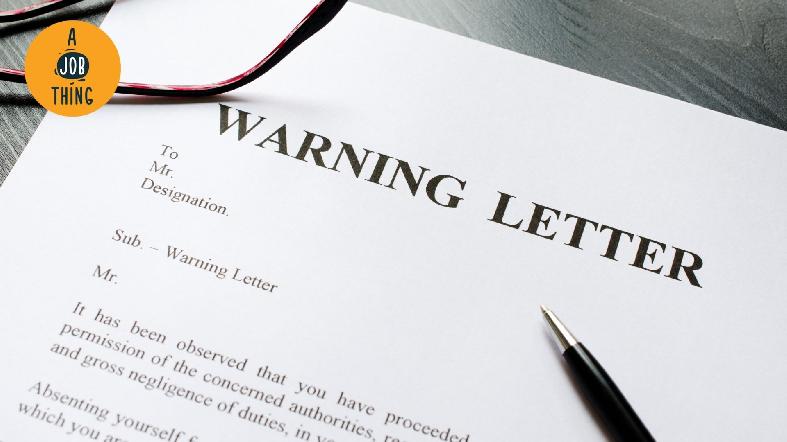
The Best Way to Write a Warning Letter
Are You Hiring?
Find candidates in 72 Hours with 5+ million talents in Maukerja Malaysia & Ricebowl using Instant Job Ads.
HIRE NOW
Warning letters are a hint that early disciplinary processes did not work, and that an employee is headed down a path toward termination.
Escalating matters "officially" may feel intimidating, but it's also a chance. A warning letter creates a paper trail and presents employees with a formal structure to get things back on track. These eight easy steps will make sure you get it right.
1. Please don't write the warning letter when you're angry
Don't write a warning letter when you're angry or stressed. Remember, you need to document things objectively, which is not easy when you're emotionally involved.
The warning letter will go in their employee record. If the employee files for a wrongful termination lawsuit, you need to share any documentation you have about an employee's performance. These documents need to stay professional.
A formal warning is also a form of progressive discipline meant to help correct employee's behaviour. Before you write, take some time to calm yourself and clear your mind from anger.
2. Document the problem
Documentation is vital for evaluating employee performance, and managers should document all types of employee interactions. Solid documentation can protect you by:
- Producing a paper trail if an employee files for a lawsuit.
- Sponsoring the decisions behind every employee action that was taken. It includes reasons why the employee is promoted, fired, or getting a raise.
- Providing a detailed timeline of employee behaviour and progressive disciplinary action.
Write the employee warning letter with documentation detailing the issue with their performance:
- Address the employee and produce a record of their behaviour up to this point.
- Apply specific examples with times and dates.
- Stick to the facts. Only write about what happened and when.
Don't say: "Ali is lazy and likes to waste time."
Say: "Ali has shown up late for his shift five times" and add which shifts those were, with the accurate clock-in times.
.jpg)
Remember, you need to stay calm and professional throughout the entire process.
3. Use company policies to back you up
Justify your reasoning and tie the employee's actions back to company policies and expectations for their role. Here are some common scenarios:
- An employee is always late to work: refer to the attendance policy.
- Dress code violations: Refer to the company policy.
- The employee continues to use social media during working hours: Refer to the company's phone usage policy.
When it comes to progressive discipline, a warning letter explains why the documented behaviour isn't up to standard and how employees should improve.
4. Include any relevant witness statements
If another employee or supervisor addressed the employee's performance issue, add their statement in your warning letter. Remember that any of these statements can be useful in the case of wrongful termination. Witness statements need to follow the same guidelines as good documentation:
- It should be a factual observation, not an opinion.
- It should help build a credible case of ongoing behaviour leading to the employee warning letter.
- It should include any efforts or disciplinary measures by supervisors to correct behaviour.
5. Set expectations for improvement
Set guidelines for how you expect the employee to fix it. Corrective feedback is honest, concentrates on the issue, and adds steps for improvement. Let the employee know what will come next after they've received their warning letter.
If the employee does not improve, and the next step is termination, make it clear so that they know what's on the line.
.jpg)
When meeting the employee, be sure to stay professional
6. Meet the employee
Schedule a meeting with the employee. Bring a witness along to verify that the meeting happened and that the employee was made aware of issues with their job performance. Then it's time for the conversation to begin:
- Share your concerns and take the employee through each instance of poor performance. If the employee asks for proof or argues that a specific issue didn't occur, use your documentation.
- Point to the company policies. Every employee read and agreed to the policies when they were hired.
- Describe what happens next and which steps you expect them to take in response to the warning letter.
7. Keep a copy for your records
Provide the employee with a copy and keep one for the records. Add it to their employee file, so there's a record or proof that they received the warning letter.
If any wrongful termination suit arises, you'll have the receipts. The documentation will show that you managed the process correctly and informed the employee every step of the way.
8. Follow up
Follow up based on the schedule you described in the disciplinary notice. See if the employee's performance improves and if they hold to the changes expected in the warning letter.
Sometimes it takes a formal warning letter to give an employee the wake-up call. If they do improve, give them more responsibility and see if they continue rising to the challenge.
Learn more about AJobThing here!
Source: When I Work
Articles you might be interested in
Can Employees be Sacked over Controversial Comments?
HR Guide: How to Write Warning Letters
Types of Employee Misconduct and Disciplinary Actions

